The NVIDIA SHIELD Tablet Review
by Joshua Ho on July 29, 2014 9:00 AM EST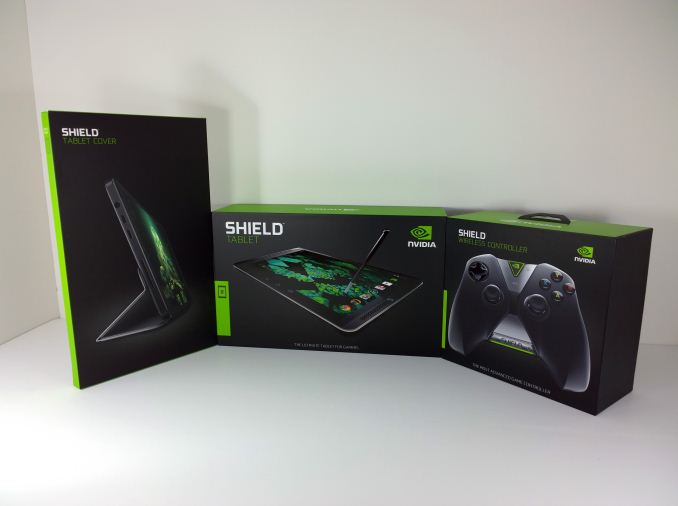
As I discussed in our launch article last week, the Shield tablet is very much the culmination of lessons learned from 2013. While the Tegra Note 7 was a decent tablet, it had to eke out a profit through hardware sales against competition that was willing to sell their tablets with no profit on hardware. Meanwhile the Shield portable was a good portable gaming device, but it was far too specialized to be anything but a gaming device. Without an established gaming ecosystem, NVIDIA struggled against established competitors.
As a result of these influences, today NVIDIA is becoming the first OEM to launch a serious gaming tablet running Android. While gaming tablets have been done before, they’ve been few and far between. Now it has always been technically possible to take a high end tablet and make it usable for gaming, but for the most part these attempts are marred by either the need for root or an application that requires extensive work on the part of the user to create proper control profiles for each game. In addition, the SoC in the tablet is often underequipped for intensive 3D gaming.
That’s where the Shield tablet comes in. With Tegra K1, a dedicated controller, 2x2 WiFi, and a huge amount of custom software, there’s definitely a lot of ground to cover. Once again, while the Shield tablet is a gaming device, it must also be a good tablet. To that end, NVIDIA has tried to differentiate this tablet with DirectStylus 2 and dual front facing speakers/bass reflex ports. I’ve included a table of specifications below to give a general idea of what the tablet is like.
| NVIDIA Shield Tablet | |
| SoC | Tegra K1 (2.2 GHz 4x Cortex A15r3, Kepler 1 SMX GPU) |
| RAM/NAND | 2 GB DDR3L-1866, 16/32GB NAND + microSD |
| Display | 8” 1920x1200 IPS LCD |
| Network | N/A or 2G / 3G / 4G LTE (NVIDIA Icera i500 UE Category 3/4 LTE) |
| Dimensions | 221 x 126 x 9.2mm, 390 grams |
| Camera | 5MP rear camera, 1.4 µm pixels, 1/4" CMOS size. 5MP FFC |
| Battery | 5197 mAh, 3.8V chemistry (19.75 Whr) |
| OS | Android 4.4.2 |
| Connectivity | 2x2 802.11a/b/g/n + BT 4.0, USB2.0, GPS/GLONASS, mini HDMI 1.4a |
| SIM Size | None or MicroSIM |
| Price | $299 or $399 (16GB/WiFi or 32GB/LTE) + $59 (optional controller) |
Hardware
Outside of the basic specs, the tablet itself has a much more subtle industrial and material design. While the large speaker grilles are maintained from the Tegra Note 7, the dimpled look and feel is gone. Instead, the finish is very much reminiscent of the Nexus 5. The feel isn’t quite rubbery the way soft touch finishes tend to be. Instead, it feels more like a high grain matte polycarbonate. Along the sides, there’s a noticeable chamfered edge where the back cover meets the display, although in practice this mostly affects aesthetics rather than in hand feel. The flip cover that is designed for the device is almost identical to the one in the Tegra Note 7, and folds up similarly. As with the Tegra Note 7, there are two angles that the flip cover can take. Overall, the aesthetic is much more subtle than the Tegra Note 7, and looks quite similar to the Nexus 7 (2013).
While it’s important for the tablet portion of the device to have decent material and industrial design, ergonomics and material design are critical for the controller. While the Shield portable had great ergonomics, it was heavy because the entire device had to fit in the controller. With Shield Tablet, that’s no longer the case. The result is that the controller is significantly lighter. While it still has some heft to it, I no longer feel the need to rest my hands against a table after significant playtime.
The controller itself is just as good as the one on the Shield Portable. The buttons, triggers, bumpers, and joysticks are all very close in feel. The one big difference are the tablet/Android controls. Instead of physical buttons, they’ve replaced the physical buttons with capacitive ones. The volume controls have also been moved down to the bottom of the controller and changed from a single button that triggers on-display volume controls to a rocker that allows direct manipulation of volume. Just above the volume rocker is a clickpad, which can be used to move a cursor through the UI. While this option exists, it’s a bit unpolished as the sensitivity isn’t tuned quite right to quickly navigate through the tablet.
Of course, there’s more to the controller than just the buttons and controls. NVIDIA has made sure to do things right by using WiFi Direct for communicating between the controller and the tablet. The frequency used depends upon what access point the tablet is connected to, so it can switch between 2.4 GHz and 5 GHz as necessary. NVIDIA claims that using WiFi Direct instead of Bluetooth drops latency by half, and also allows for microphone input and sound output via 3.5mm jack through the controller. In practice, the controller works great. I don’t have any complaints about this at all. Pairing is as simple as pressing and holding on the NVIDIA logo for a few seconds, then opening the pairing application. Up to four controllers can be paired to the tablet this way, which introduces interesting possibilities for local multiplayer games such as Trine 2. I also didn’t notice a difference in response time of the wireless controller when compared to the wired controller of Shield Portable. It’s incredibly important to get the controller right for gaming devices, and NVIDIA has nailed it. Overall, I’m happy with the basic hardware for both the controller and tablet. While it would be interesting to see a metal unibody design on the tablet, it’s difficult to justify at the price point that this device has to hit.
Of course, while hardware is important, software makes or breaks this tablet, so that’s next.


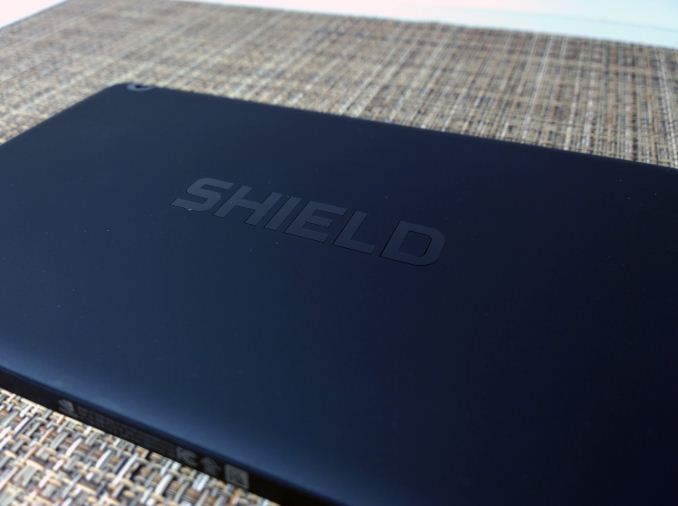
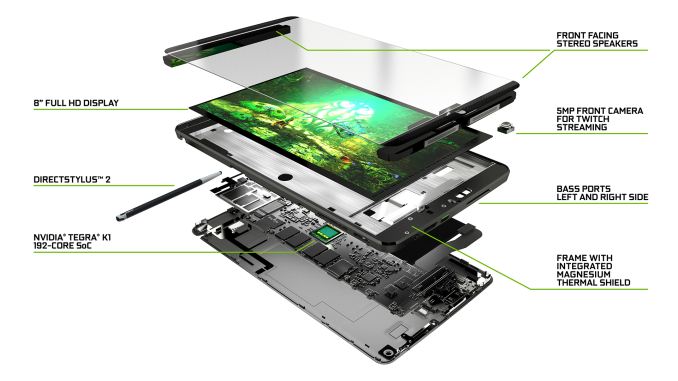
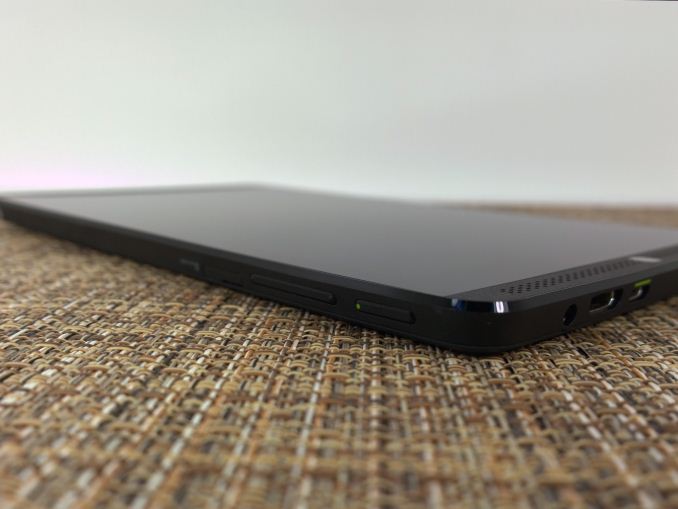
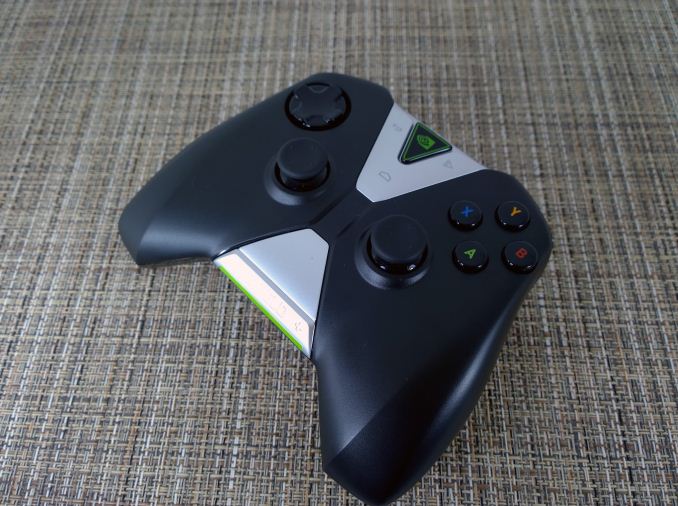








174 Comments
View All Comments
TheJian - Wednesday, July 30, 2014 - link
Full 3.1 ES support and OpenGL 4.4. Being based on desktop gpus it should become a very good emu platform over time. I wonder if a 20nm M1 would be totally able to play wiiu games too? I find myself wanting to hold out for a 20nm version of NV's chip for a serious boost in power for gaming since android seems to be really taking off in this area. I couldn't justify a tablet before just as a tablet, but my list of android games I want to play is growing so might have to bite soon. Dad's nexus 10 isn't good enough for many things (dang res being too high). I hope NV sticks with 1080p/1200p for a while so gaming just gets better not slower on android. Above this is just stupid in something under 13in with gaming as an intention.Another review showed it running emus and Zelda Ocarina of time.
http://gizmodo.com/nvidia-shield-tablet-review-a-g...
Mupen64. Dolphin guys will probably adapt it to K1 soon I'd guess. The power and features are there. N64 games work at least according to gizmodo guy. I'm not really interested in anything before n64's time but there's some pretty fun stuff on n64 or better I wouldn't mind playing today (never owning any nintendo product previously).
Knowname - Wednesday, July 30, 2014 - link
the controller is certainly as uncomfortable as an n64's *bazinga*NZtechfreak - Monday, August 18, 2014 - link
Dolphin will run, on time trial mode (no other racers onscreen) in Double Dash it gets 40-60fps, with high 40 to high 50s the majority of the time. Haven't yet tried a lot of other stuff. The Dolphin developers are really looking forward to the 64-bit K1.bossmoogle - Tuesday, July 29, 2014 - link
I'm considering one of these but for me an important factor that wasn't discussed in the review was the glass on the display. I'm guessing it's not GorillaGlass. Is it scratch resistant at all? I'm on a Nexus 7 2013 right now and the GOrillaGlass is just amazing, if I wipe my screen off it still looks pristine as if it had just gotten off the assembly line. Not a single micro scratch is visible in the sunlight. Once you've used something like that it's very hard to go back to a screen you know is going to get all scratched up.schizoide - Tuesday, July 29, 2014 - link
The nexus7 2013 actually uses Corning's "Fit" or "Concore" glass, which is not as scratch resistant as corning gorilla glass.I researched it briefly but was unable to find what the shield tablet uses. So I agree that it's probably not gorilla glass, or they would have said so.
kron123456789 - Tuesday, July 29, 2014 - link
Good thing about games on this tablet is that Tegra K1 optimized games are using desktop OpenGL, not mobile OpenGL ES.kidconcept - Tuesday, July 29, 2014 - link
> Of course, the real question here is whether the gaming side is worth the price premium.Can you mention some other tablets the Shield has to compete with on price? For example, the Nexus 7 costs about $60 dollars more than the Shield (16GB +$70, 32GB-LTE +$50). Anything else in the same class as the Shield that is significantly cheaper?
Great review BTW. Hit all the important points for most of the audience. As an artist, I'm curious about how the stylus performs, but I recognize that nobody else really cares about it.
schizoide - Tuesday, July 29, 2014 - link
You've got that backwards. The Nexus 7 16GB retails for $230 and the Nexus 7 32GB model with LTE at $350.The nvidia shield tablet 16GB retails for $300, and the 32GB model with LTE will sell for $400.
schizoide - Tuesday, July 29, 2014 - link
Also like I posted earlier, if you're OK with manufacturer refurbs, you can pick up a N7 16GB refurb from an authorized reseller for $140 on eBay. Half the price.kidconcept - Tuesday, July 29, 2014 - link
Refurbs isn't really a great price comparison.